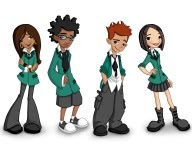Emoticons. You may think of them as a recent fad-- something invented by the Internet generation or Generation Text. But emoticons have actually been around a lot longer than you may think. How long, exactly? How about the nineteenth century?
Way Back When
A New York Times article from earlier this year talked about a recently-discovered New York Times transcript of a speech given by President Abraham Lincoln in 1862 that contains a mark that some have suggested might be a winking emoticon. Some experts have argued that the mark might just be a typo or a legitimate form of punctuation, but some believe, based on its location in the text, that it could be one of the first documented emoticons.
Even if that sly little wink in the New York Times transcript wasn't on purpose, all you have to do is fast-forward a few years to 1881 to find an indisputable use of emoticons. In March of that year, an American satirical magazine called Puck included suggestions for humorous typographical emoticons. (Just to give you a little frame of reference, that was seven months before the famous cowboy gunfight at the O.K. Corral in Tombstone, Arizona. Can you imagine Doc Holliday using emoticons?)
Turn of the (Twentieth) Century
In 1912, Ambrose Bierce, author of The Devil's Dictionary, suggested a punctuation mark similar to a horizontal parenthesis that he called "the snigger point, or note of cachinnation." The mark was meant to represent "as nearly as may be, a smiling mouth. It is to be appended, with the full stop, to every jocular or ironical sentence; or, without the stop, to every jocular or ironical clause of a sentence otherwise serious."
If that's not an emoticon, I don't know what is.
In our Lifetime
Various emoticons were used as shorthand throughout the seventies, including -) as a symbol to indicate "tongue in cheek." But the emoticons that we're most familiar with (our old friends :-) and :-( ) were created and proposed by Scott Fahlman in a proposal posted to the Carnegie Mellon University computer science general board on September 19, 1982. Yes, you read that correctly. He actually made a formal proposal for the use of happy face emoticons.
The number of emoticon variations seems to be endless. I can't tell you how many times I've been talking with someone on instant messenger or through text and they send me an emoticon that I have to turn every which way to decipher. Usually, though, I can figure it out using context clues. Hooray for reading comprehension skills!
What are some of the crazy emoticons you've run into? What are some of your favorites to use? Let us know! It's always helpful to get a few more additions to our emoticon vocabulary.
Monday, November 16, 2009
Subscribe to:
Post Comments (Atom)




Nice! this helps with my research paper! ;)
ReplyDelete